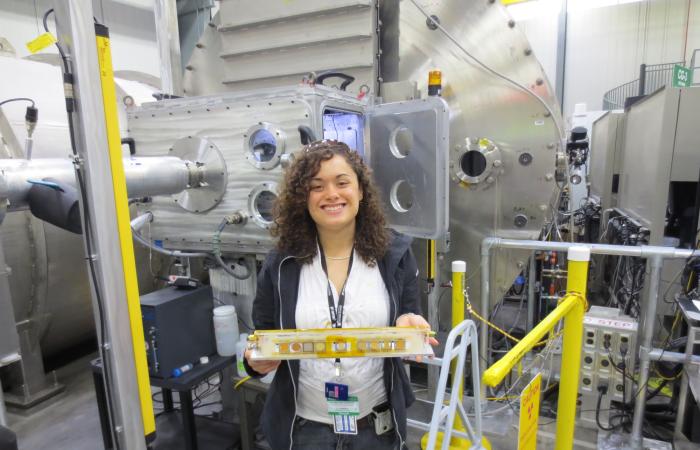Essential support for the country’s researchers
U.S. Forest Service researcher Nayomi Plaza had an important question: What happens to wood at the molecular level when it’s exposed to humidity?
The answer will give us a better understanding of the movement of water in lumber, allowing us to choose better anti-decay treatments and improve the lumber for construction and other uses.
To find it, Plaza chose neutron scattering — a technique that’s uniquely good at studying the behavior of water.
Since the Forest Products Laboratory does not have the equipment to perform needed neutron scattering tests, Plaza partnered with ORNL and its world-leading neutron facilities — the accelerator-based Spallation Neutron Source and the reactor-based High Flux Isotope Reactor — to address these research questions.
“My work supports the Forest Service mission of sustaining our nation’s forests and grasslands by unlocking the potential of wood, our most abundant and renewable resource” Plaza said, “and ORNL is instrumental to my research.”
Bringing in researchers
SNS and HFIR are just two of eight ORNL user facilities that help researchers from around the country and around the world by giving them access both to world-leading resources they couldn’t possibly afford and to expert staff that ensure they take full advantage of those facilities.
ORNL user facilities advance research in a wide range of science and technology, from explorations of the nature of the universe and its origins to the development of advanced manufacturing technologies that keep the United States competitive.
SNS and HFIR are among the lab’s premier user facilities. Along with the Oak Ridge Leadership Computing Facility — home to the world’s most powerful supercomputer, Frontier — and the Center for Nanophase Materials Sciences, they are sponsored by DOE’s Office of Science (see “Getting down to basic: Going big to study the very small,” page 14, and “OLCF: Serving up bleeding-edge compute power and expertise to the world’s scientists,” page 18).
“The Department of Energy is the major funder of physical sciences in the United States,” noted ORNL Laboratory Director Thomas Zacharia. “One of the main functions of the Office of Science is to enable scientific discoveries and technological advances by providing unique user facilities not only to ORNL scientists, but to collaborators from across the United States and even around the world.”
Arizona State University molecular biophysicist Abhishek Singharoy uses ORNL’s Summit supercomputer, ranked fourth fastest in the world, to study the behavior of proteins in living cells, focusing on mitochondria, a cell’s components for producing energy, and on viruses and vaccines. His work offers insights into the aging process as well as the treatment of viral infections.
The molecular dynamics simulations that his team performs are extremely demanding, requiring a supercomputer of Summit’s abilities.
“The kinds of simulations we do involve millions of variables,” he said, “and each variable has basically six dimensions that need to be monitored. That brings us to 6 million to 60 million variables that need to be monitored every millisecond of the calculation.”
Singharoy’s research also benefits from Summit’s strengths in machine learning and artificial intelligence, which streamline simulations on the fly, allowing Singharoy and his colleagues to tackle even more challenging problems.
“Summit allows us to think about problems that were previously unthinkable,” he said.
Helping the economy with advanced tech
The lab also hosts user facilities dedicated to applied research. Sponsored by DOE’s Office of Energy Efficiency and Renewable Energy, these include the Building Technologies Research and Integration Center, the Carbon Fiber Technology Facility, the Manufacturing Demonstration Facility and the National Transportation Research Center.
Cleveland, Ohio-based Lincoln Electric is one user taking advantage of ORNL’s expertise in applied research. The company collaborates with the MDF to develop and improve metal 3D printing for heavy industries such as power plants and oil and gas refineries. Specifically they’re focused on large machines that produce components using additive manufacturing with melted wire.
“A lot of the work that we're doing with Oak Ridge is to help push the envelope as far as capabilities go: the materials that can be printed, the speed at which things can be printed, controlling the depositions for quality and accuracy,” said D. Mark Douglass, business development manager for Lincoln Electric Additive Solutions.
That relationship also gives the company access to the lab’s neutron scattering facilities, which allow them to ensure the quality of the printed parts by checking for stresses and defects.
“Much of our effort is in characterizing the material,” Douglass said. “What’s the residual stress like? What are the mechanical properties like? What kind of discontinuities — some people call them defects — would you expect, and how do you control or minimize those?”
Lincoln also relies on ORNL for other testing. For instance, it's working with an iron–nickel alloy called Invar, which resists expansion and contraction when it is heated and cooled — a quality known as a low coefficient of thermal expansion.
“We would deposit various samples of different chemistries, and then the lab would test those chemistries for the critical variable, namely the coefficient of thermal expansion.”
As always, it’s about the people
Zacharia stressed that the value of ORNL’s user facilities goes well beyond their technical capabilities to the expertise and commitment of their staff. These collaborations ensure that researchers make the most of these unique facilities, maximizing their impact on science and technology.
“What makes ORNL and these user facilities unique is not just their capability; it’s the people — the scientists and technicians. When collaborators engage the user facilities, they are interacting not only with the equipment but also with extraordinary scientists and technicians who are part of our staff.”
These collaborations were especially valuable during the pandemic, he noted.
“In the last two years, much of the work has been done by our staff, because the users simply they could not be here themselves.” Zacharia said.
Plaza, Singharoy and Douglass agree.
Plaza’s neutron research into wood and humidity used custom-made humidity chambers that allowed her to observe at the nanoscale how water moves in wood, how the wood swells when exposed to water, and how the process is affected by the treatments used to prevent decay.
“The people at ORNL have been absolutely wonderful,” she said. “They’ve been super helpful as we’ve worked together coming up with new humidity cell environments so that I can do my experiments with humidity control.”
Singharoy also praised his ORNL collaborators.
“The OLCF staff have been amazing,” he said. “Working with them has been a pleasure. Anytime we get stuck somewhere, the OLCF staff have been extremely helpful, working with us hand-in-hand toward solving these problems.”
Jason Flamm, engineering and operations manager for Lincoln Electric Additive Solutions, praised MDF staff both for their strength as collaborators and their help in getting the company access to the lab’s neutron scattering facilities.
“MDF is a world-renowned expert in the area of additive manufacturing, especially large-scale additive manufacturing,” he said. “They’ve got many knowledgeable people with lots of experience and breadth of experience.”
Douglass also said he appreciated the perspective of ORNL’s researchers, who are able to take a longer-term approach to technology development.
“Oak Ridge has the ability to look out into the future and have a longer horizon with some of the applications they’re looking at. We wouldn’t necessarily be giving them the same attention because of the demands of business.”



